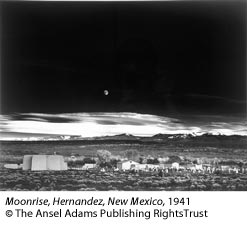|
ANSEL ADAMS: Classic Images Moonrise, Hernandez, New Mexico, 1941 This image is copyrighted by The Ansel Adams Publishing
Rights Trust and cannot be printed or reproduced in any way. The
use of the photograph is limited to viewing in the context of this
web site.
|
|
|
Moonrise, Hernandez, New Mexico, 1941 Main Source: Examples - The Making of 40 Photographs by Ansel Adams, pp 41-43 A. Why do you think this is the most famous photograph
by Ansel Adams? A. Why do you think this is the most famous photograph
by Ansel Adams? Do you notice how the photograph is divided according to the "Rule
of Thirds?" Moonrise is "certainly my most popular single image", said Adams. It "combined serendipity and immediate technical recall." Serendipity means lucky chance. He "felt at the time it was an exceptional image" and when he took it, he felt "an almost prophetic sense of satisfaction." Are photographs sold like paintings? What value do they have? There
are patrons and collectors of photographs as well as for other fine
arts. Ansel Adams was lucky to have attracted many influential and wealthy
people who financed the production of the portfolios of his work, who
arranged for exhibitions, and who purchased his work. When he was a
young creative photographer, his original prints sold for $10, and in
the 1960s for $50 - $100. The price for a print of Moonrise in
the early 1970s was $500. Then the value of the creative photographs
of Ansel Adams skyrocketed. At an auction in 1981, the sale of Moonrise
set a record price for a photograph - $71,500! B. How did chance lead him to take this photograph? C. How did scientific analysis of the moon help Adams date this
photograph? D. How important is "the moment" in photography? E. Once the photograph is taken, is the development and printing
a mechanical process? F. Technical Aspects
G. Related links in this site
|
|
|
ANSEL ADAMS: Classic Images Moonrise, Hernandez, New Mexico, 1941 This image is copyrighted by The Ansel Adams Publishing
Rights Trust and cannot be printed or reproduced in any way. The
use of the photograph is limited to viewing in the context of this
web site.
|
|
|
Moonrise, Hernandez, New Mexico, 1941 Main Source: Examples - The Making of 40 Photographs by Ansel Adams, pp 41-43 A. Why do you think this is the most famous photograph
by Ansel Adams? A. Why do you think this is the most famous photograph
by Ansel Adams? Do you notice how the photograph is divided according to the "Rule
of Thirds?" Moonrise is "certainly my most popular single image", said Adams. It "combined serendipity and immediate technical recall." Serendipity means lucky chance. He "felt at the time it was an exceptional image" and when he took it, he felt "an almost prophetic sense of satisfaction." Are photographs sold like paintings? What value do they have? There
are patrons and collectors of photographs as well as for other fine
arts. Ansel Adams was lucky to have attracted many influential and wealthy
people who financed the production of the portfolios of his work, who
arranged for exhibitions, and who purchased his work. When he was a
young creative photographer, his original prints sold for $10, and in
the 1960s for $50 - $100. The price for a print of Moonrise in
the early 1970s was $500. Then the value of the creative photographs
of Ansel Adams skyrocketed. At an auction in 1981, the sale of Moonrise
set a record price for a photograph - $71,500! B. How did chance lead him to take this photograph? C. How did scientific analysis of the moon help Adams date this
photograph? D. How important is "the moment" in photography? E. Once the photograph is taken, is the development and printing
a mechanical process? F. Technical Aspects
G. Related links in this site
|
|
